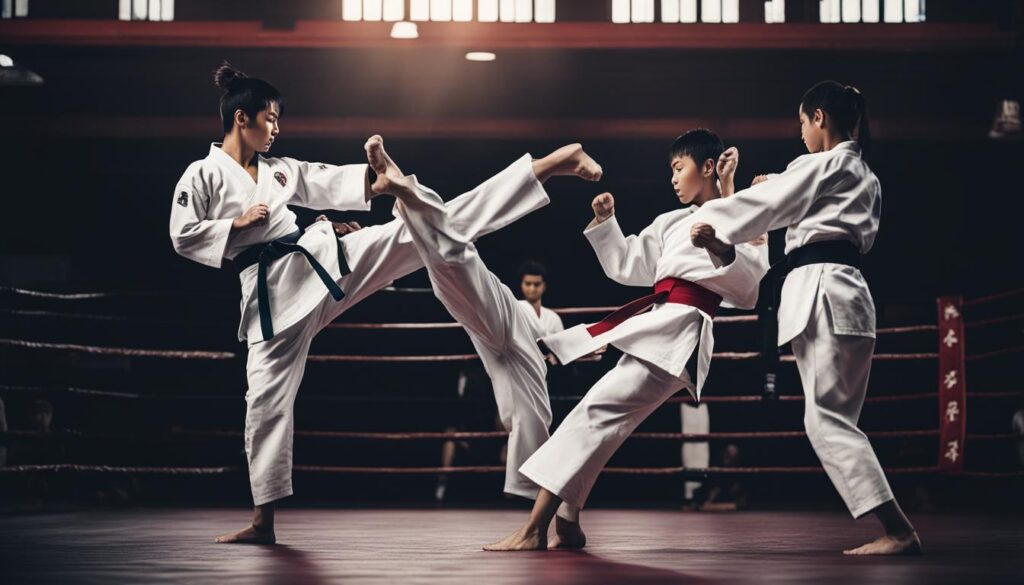Welcome to our comprehensive comparison of two popular martial arts: Karate and Taekwondo. Both styles are known for their dynamic strikes and have dedicated followers worldwide. In this article, we will explore the differences between Karate and Taekwondo, and help you determine which martial art may be superior for self-defense, fitness, and personal development.
Key Takeaways:
- Karate and Taekwondo are both traditional striking martial arts.
- Karate originated in Japan and focuses on punches, kicks, and takedowns.
- Taekwondo originated in Korea and emphasizes kicking techniques.
- Both martial arts have their strengths and weaknesses for self-defense.
- Karate and Taekwondo offer unique benefits for fitness and personal development.
The History of Karate and Taekwondo
Karate and Taekwondo have rich histories that span centuries, originating in different parts of the world. Let’s explore the fascinating origins and development of these two martial arts.
Origins of Karate
Karate traces its roots back approximately 500 years to the island of Okinawa in Japan. It emerged as a result of blending indigenous fighting techniques with Chinese martial arts. The term “karate” itself translates to “empty hand,” highlighting the unarmed combat nature of the art.
Gichin Funakoshi, often referred to as the father of modern Karate, played a significant role in popularizing the art. He, along with other masters, developed the Shotokan style, which became one of the most influential forms of Karate. Funakoshi’s efforts led to the introduction of Karate on mainland Japan in the early 20th century.
Origins of Taekwondo
Taekwondo has ancient origins in Korea, with records of hand-to-hand combat styles being practiced as early as 50 B.C.E. Known by different names throughout history, it wasn’t until the 1950s that Taekwondo as we know it today began to take shape.
The Japanese occupation of Korea in the early 20th century resulted in the banning of martial arts training. However, Taekwondo continued to be practiced secretly. After Korea regained its independence, efforts were made to officially develop Taekwondo as a national martial art. In 1955, different Korean martial arts styles were merged, leading to the establishment of Taekwondo with its distinctive techniques and philosophies.
| Aspect | Karate | Taekwondo |
|---|---|---|
| Origins | Okinawa, Japan | Korea |
| Development | Combination of Chinese and indigenous fighting techniques | Merging of different Korean martial arts styles |
| Famous Figure | Gichin Funakoshi | Not applicable |
| Fighting Techniques | Punches, kicks, takedowns | Emphasis on kicking techniques |
| Forms | Katas | Poomsaes |
| Belt System | Various belt colors signify rank and progress | Dan (black belt) system |
The Similarities between Karate and Taekwondo
Karate and Taekwondo are both traditional striking martial arts that share several similarities. These martial arts involve a combination of punches and kicks, making them effective in stand-up combat situations. Both Karate and Taekwondo have forms that practitioners learn and practice, known as katas in Karate and poomsaes in Taekwondo. These forms are choreographed sequences of movements that help develop technique, balance, and coordination.
Another similarity between Karate and Taekwondo is the use of belt systems. Both martial arts use colored belts to signify rank and progress in training. The belt system provides a tangible way for practitioners to track their progress and set goals for advancement. It also fosters a sense of achievement and motivation as practitioners work their way up through the belt levels.
It is worth noting that Karate has had a significant influence on the development of Taekwondo. When Taekwondo was being formalized in the 1950s, Karate techniques and principles were integrated into the art. This influence is evident in some of the striking techniques and stances used in Taekwondo.
Lastly, both Karate and Taekwondo have gained immense popularity worldwide. They are practiced by millions of people of all ages, from kids to adults. The appeal of these martial arts lies in their effectiveness as striking arts, their focus on discipline and personal growth, and the physical and mental benefits they offer.
To visually demonstrate the similarities between Karate and Taekwondo, here is a concise table:
| Karate | Taekwondo |
|---|---|
| Traditional striking martial art | Traditional striking martial art |
| Involves punches and kicks | Involves punches and kicks |
| Forms known as katas | Forms known as poomsaes |
| Uses belt systems to signify rank | Uses belt systems to signify rank |
| Influenced the development of Taekwondo | Formalized by integrating Karate techniques |
| Popularity worldwide | Popularity worldwide |
The Differences between Karate and Taekwondo
While Karate and Taekwondo share similarities, they also have distinct differences. Karate is a Japanese martial art, while Taekwondo originated in Korea. In terms of techniques, Karate is known for its well-rounded approach, incorporating punches, kicks, knees, elbows, and open-hand techniques. Taekwondo, on the other hand, focuses primarily on kicking techniques and is known for its variety of kicks, including jumping and spinning kicks. The movement in Karate is often linear, while Taekwondo fighters aim to maintain distance and use kicks to keep opponents at bay. The belt systems in Karate and Taekwondo also differ, although both use belts to signify rank and progress.
Techniques
When it comes to techniques, Karate and Taekwondo have different emphases. Karate practitioners learn a wide range of striking techniques, including punches, kicks, knees, elbows, and open-hand techniques. This well-rounded approach allows Karate practitioners to adapt to various combat situations and engage in both close-range and mid-range fighting. On the other hand, Taekwondo places a heavy emphasis on kicking techniques. Taekwondo practitioners learn various kicks, including roundhouse kicks, front kicks, side kicks, and spinning kicks. The focus on kicks in Taekwondo creates a distinct fighting style that relies on long-range attacks and the ability to keep opponents at a distance.
Movement and Fighting Style
The movement and fighting style in Karate and Taekwondo also differ. Karate practitioners typically use linear movement, advancing or retreating in straight lines. This straight forward movement allows for efficient footwork and quick transitions between different techniques. In contrast, Taekwondo fighters aim to maintain distance and create space between themselves and their opponents. They utilize jumping and spinning kicks to maintain distance and deliver powerful strikes from a safe distance. This long-distance fighting style requires agility, flexibility, and excellent control of kicks.
Belt Systems
The belt systems in Karate and Taekwondo vary. In Karate, the belt system typically consists of different colored belts that signify a practitioner’s progress and rank. The belt colors usually include white, yellow, orange, green, blue, brown, and black, with different levels within each color. On the other hand, Taekwondo uses a similar belt system but often assigns additional stripes or bars to indicate intermediate ranks between belt colors. This allows for more gradual progression and recognition of a practitioner’s achievements.

In the next section, we will explore the strengths of Karate and Taekwondo, highlighting their unique benefits in terms of self-defense, fitness, and personal development.
The Strengths of Karate and Taekwondo
Karate and Taekwondo each have their own unique strengths that make them formidable martial arts. Let’s take a closer look at what sets them apart.
Karate’s Strengths
Karate is renowned for its well-rounded striking system, incorporating a wide range of techniques such as punches, kicks, and other striking methods. This comprehensive approach allows practitioners to develop versatility in their striking abilities, making them adaptable in various combat scenarios. Moreover, Karate emphasizes mental and physical discipline, fostering a strong mindset and honing the practitioner’s focus, determination, and resilience.
Taekwondo’s Strengths
Taekwondo excels in kicking techniques, offering a vast repertoire of powerful kicks that can be executed with remarkable speed and precision. Practitioners of Taekwondo undergo extensive training to develop excellent kicking control, enabling them to maintain distance from opponents effectively. The focus on kicking techniques in Taekwondo makes its practitioners formidable opponents in terms of sheer kicking power.
The Weaknesses of Karate and Taekwondo
While Karate and Taekwondo have their strengths, it’s important to acknowledge their weaknesses as well. Understanding these weaknesses can provide valuable insights when considering which martial art is best suited for individual preferences and goals.
Weaknesses of Karate:
Karate can be predictable in its movements and techniques, making it easier for an opponent to read and counter. Due to its emphasis on striking, Karate may have limited emphasis on grappling techniques, depending on the particular style being practiced.

| Weaknesses of Karate |
|---|
| Predictable movements and techniques |
| limited emphasis on grappling techniques, depending on the style |
Weaknesses of Taekwondo:
Taekwondo’s primary focus on kicking techniques can render it less effective in close-quarter combat situations. The emphasis on kicks may also result in a lack of a well-rounded approach compared to other martial arts, which incorporate a wider range of techniques.
| Weaknesses of Taekwondo |
|---|
| Less effective in close-quarter combat situations |
| Lack of a well-rounded approach compared to other martial arts |
While these weaknesses exist, it’s important to note that they can be overcome through dedicated training and a comprehensive understanding of self-defense principles. By addressing these weaknesses, practitioners can enhance their skills and become more well-rounded martial artists.
Conclusion
In conclusion, when comparing karate and taekwondo, it is essential to consider individual preferences, goals, and circumstances. Both martial arts offer unique strengths and weaknesses that can cater to different needs.
Karate provides practitioners with versatility in striking techniques, incorporating punches, kicks, knees, elbows, and open-hand techniques. This makes it a well-rounded martial art suitable for self-defense, fitness, and personal development. On the other hand, taekwondo excels in powerful kicks and maintaining distance, equipping practitioners with exceptional kicking control and speed. It is a popular choice for those interested in fitness and developing powerful kicking techniques.
Ultimately, the effectiveness of karate or taekwondo in self-defense, fitness, and personal development relies heavily on the dedication and training of the individual. Regardless of age, both martial arts can be beneficial for kids and adults, as they offer opportunities for physical exercise, discipline, and personal growth.
The decision between karate and taekwondo should be based on an individual’s interests, goals, and personal preferences. Choosing the right martial art is crucial for a fulfilling and enjoyable journey. Whether you prioritize the well-rounded striking techniques of karate or the powerful kicks of taekwondo, both martial arts have much to offer in terms of self-defense, fitness, and personal development.
FAQ
What is the difference between Karate and Taekwondo?
Karate originated in Japan and incorporates punches, kicks, and takedowns, while Taekwondo originated in Korea and focuses primarily on kicking techniques.
Which martial art is better for self-defense, Karate or Taekwondo?
Both Karate and Taekwondo can be effective for self-defense, but it ultimately depends on the individual’s training and application of techniques.
Are Karate and Taekwondo good for fitness?
Yes, both Karate and Taekwondo provide a great workout and can improve strength, flexibility, and cardiovascular health.
Can children learn Karate or Taekwondo?
Yes, Karate and Taekwondo are suitable martial arts for children, as they teach discipline, focus, and self-confidence, in addition to physical skills.
Are Karate and Taekwondo suitable for adults?
Yes, adults can benefit from learning Karate or Taekwondo, as they offer physical fitness, stress relief, and the opportunity to learn self-defense techniques.
What are the benefits of learning Karate and Taekwondo?
Learning Karate and Taekwondo can improve physical fitness, promote discipline, enhance self-confidence, teach self-defense skills, and provide opportunities for personal growth.
Which martial art involves more striking techniques, Karate or Taekwondo?
Karate incorporates a variety of striking techniques, including punches, kicks, knees, elbows, and open-hand techniques. Taekwondo primarily focuses on kicking techniques.
How do the belt systems differ between Karate and Taekwondo?
While both Karate and Taekwondo use belt systems to signify rank and progress in training, the specific belt colors and requirements can vary between styles and schools.
